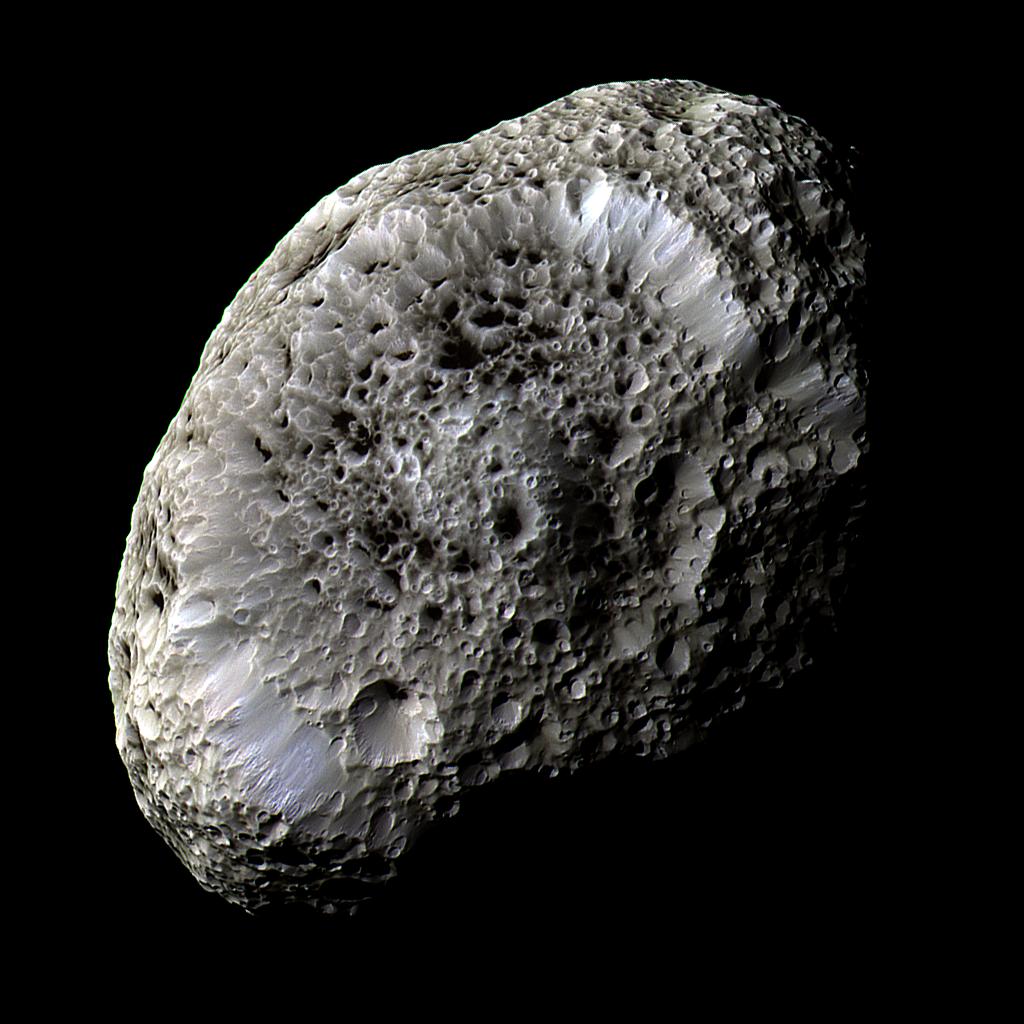Hyperion

William Lassell discovered Hyperion in 1848. That same year William Cranch Bond, with his son George Phillips Bond, independently discovered the moon. All three men are jointly credited with the discovery.
Hyperion is the largest of Saturn's irregular, nonspherical moons. Hyperion's mean radius is 83.9 miles (135 kilometers), but since Hyperion is rather potato-shaped, its shape can be described in terms of its diameter along its three axes: 255 x 163 x 137 miles (410 x 260 x 220 kilometers, respectively). Considering its odd shape, Hyperion is probably a remnant of a larger moon that was destroyed by a major impact.
Hyperion's density is slightly more than half that of water. This could be due to water ice with gaps (porosity) of more than 40 percent. Also, lighter materials, such as frozen methane or carbon dioxide, could make up part of Hyperion. This is consistent with the concept of Hyperion accreting from a number of smaller ice and rock bodies, but not having enough gravity to compact them. Thus, Hyperion might be similar to a large rubble pile.
Hyperion rotates chaotically, tumbling unpredictably through space as it orbits Saturn. Hyperion orbits at a mean distance of 933,000 miles (1,500,000 kilometers) from Saturn in an eccentric orbit. This contributes to variations in the spin or rotation of Hyperion. A stronger effect on Hyperion's rotation is that it is in resonance with Saturn's largest moon, Titan, which orbits at 759,200 miles (1,221,850 kilometers). Thus, the two objects speed up and slow down as they pass each other in a complex set of variations. Because Hyperion is much smaller than Titan, its rotation and orbit are affected vastly more than the larger moon, and Titan apparently keeps the Hyperion orbit eccentric rather than growing more circular over time.
The great distance from Saturn and resonance with Titan has also kept Hyperion from becoming tidally locked facing Saturn. Hyperion rotates roughly every 13 days during its 21-day orbit.
The most noticeable close-up feature of Hyperion is its deeply cratered surface. Hyperion and its sister outer moons, Phoebe and Iapetus, all show extensive cratering because they are Saturn's most distant moons and have experienced very little tidal warming that might blur or erase earlier features. However, the Hyperion craters are particularly deep and do not have significant rays of ejecta (although there appears to have been slumping or landslides inside many of the bigger craters). The result is a curiously punched-in look, somewhat like the surface of a sponge or a wasp nest. Planetary geologists have theorized that Hyperion's high-porosity and low density would crater more by compression than excavation.
Many of the crater walls on Hyperion are bright, which suggests an abundance of water ice. The crater floors are mostly the areas of the lowest albedo (a measure of how reflective the surface is) and greatest red coloration. This may be because the average temperature of roughly -300 degrees Fahrenheit (-180 degrees Celsius) might be close enough to a temperature that would cause volatiles to sublimate, leaving the darker materials accumulated on the crater floors. This scenario fits with some of the newer crater floors being bright water ice.
John Herschel suggested that the moons of Saturn be associated with the mythical brothers and sisters of Kronus. (Kronus is the equivalent of the Roman god Saturn in Greek mythology.)
The name Hyperion comes from the Greek god (or Titan) Hyperion (he who watches over). Hyperion, the son of Uranus and Gaia, is a brother of Kronus and the husband of Thea. The children of Hyperion and Thea include Helios (the sun), Eos (the dawn) and Selene (the Moon).




